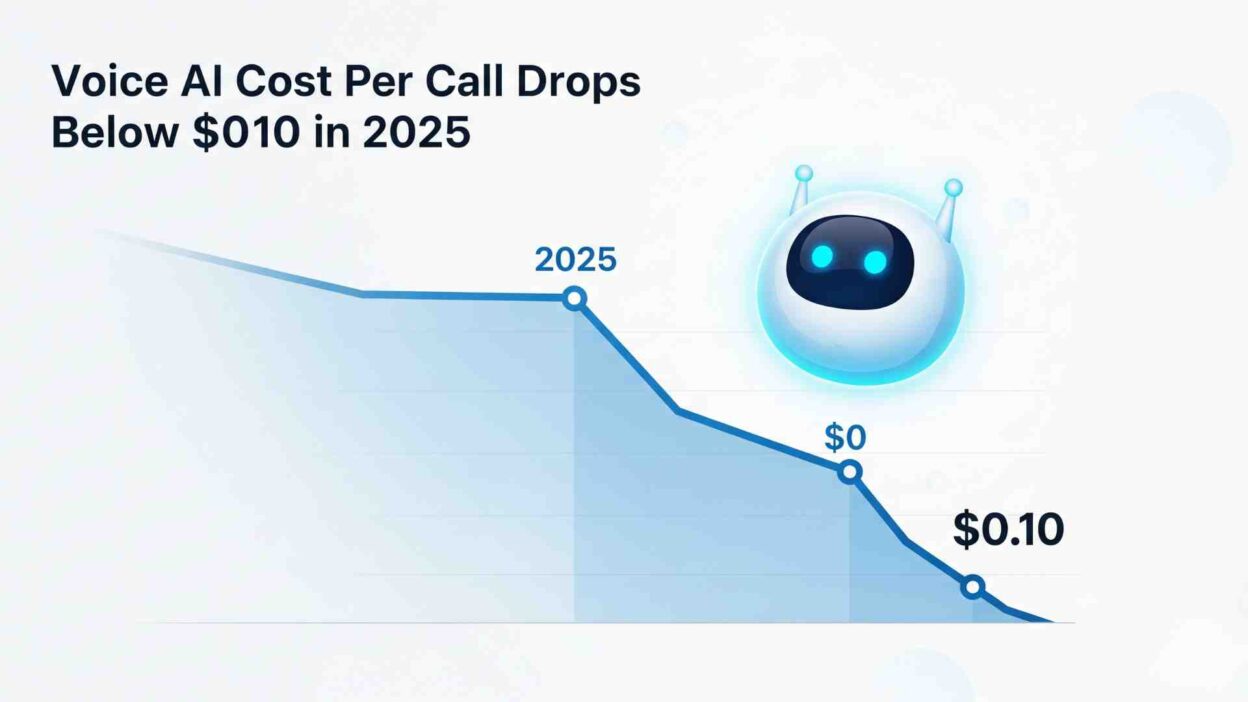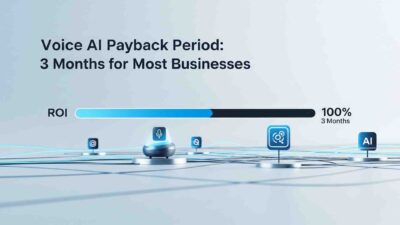TL;DR Voice AI cost per call has reached an unprecedented low of under $0.10 in 2025. This breakthrough marks a revolutionary shift in automated communication technology. Businesses worldwide are witnessing dramatic cost reductions in their voice automation systems.
Table of Contents
The telecommunications industry has transformed completely. Traditional phone systems once charged dollars per minute. Modern voice AI solutions now deliver premium quality at a fraction of previous costs.
Revolutionary Voice AI Cost Per Call Reduction Changes Everything
The voice AI market experienced explosive growth in 2025. Major providers slashed pricing by 70% compared to 2024 rates. Competition between AI companies created this perfect storm of affordability.
Technology improvements drove down operational expenses significantly. Advanced neural networks process voice data more efficiently. Cloud infrastructure costs decreased substantially across all major platforms.
Businesses report massive savings from implementing voice AI systems. Customer service departments reduced operational costs by 60-80%. Sales teams automated follow-up calls at unprecedented low rates.
Market Forces Behind Ultra-Low Voice AI Cost Per Call
Several factors contributed to this dramatic price reduction. Machine learning algorithms became exponentially more efficient. Processing power requirements decreased by half compared to previous generations.
Silicon chip manufacturers increased production capacity dramatically. Graphics processing unit costs dropped 40% year-over-year. Memory storage became significantly cheaper across all technology sectors.
Voice AI cost per call benefits extended beyond basic pricing. Implementation times shortened from months to weeks. Technical complexity reduced substantially for non-technical users.
Competition intensified among voice AI providers globally. New market entrants offered aggressive pricing strategies. Established companies responded with matching or lower rates.
Real-World Voice AI Cost Per Call Implementations
Healthcare systems adopted voice AI for patient scheduling. Average costs dropped from $2.50 per call to $0.08. Appointment confirmation rates increased by 35% simultaneously.
E-commerce companies implemented voice AI for order tracking. Traditional call center costs averaged $3.20 per interaction. Voice AI reduced this to just $0.09 per call.
Financial institutions deployed voice AI for account inquiries. Previous costs reached $4.50 per customer service call. Voice AI cost per call now averages $0.07 across major banks.
Insurance companies revolutionized claims processing through voice automation. Manual processing cost $8.75 per claim call. Automated systems reduced this to $0.06 per interaction.
Premium Features Available at Budget Voice AI Cost Per Call Rates
Modern voice AI platforms offer enterprise-grade capabilities affordably. Multi-language support comes standard across most providers. Emotional intelligence features enhance customer interaction quality significantly.
Real-time transcription accuracy exceeds 98% on average. Voice recognition works flawlessly across different accents. Background noise filtering eliminates most environmental interference.
Integration capabilities expanded dramatically throughout 2025. Popular CRM systems connect seamlessly with voice AI. API documentation improved substantially for developer implementation.
Custom voice training takes hours instead of weeks. Businesses create branded voice personalities quickly. Training data requirements decreased by 80% compared to earlier systems.
Advanced Analytics Transform Voice AI Cost Per Call Value
Comprehensive reporting dashboards provide detailed call analytics. Conversion tracking measures success rates automatically. Customer sentiment analysis identifies improvement opportunities instantly.
Performance metrics update in real-time during conversations. Call quality scores help optimize voice AI responses. Competitive benchmarking shows industry position clearly.
Cost analysis tools calculate exact savings per campaign. ROI calculations demonstrate immediate business value. Budget forecasting becomes accurate down to individual calls.
Security Features Don’t Compromise Voice AI Cost Per Call Savings
Enterprise-grade encryption protects all voice data transmissions. Compliance certifications meet strictest industry standards. Data residency options satisfy regional legal requirements.
Privacy controls give customers complete data ownership. Deletion policies ensure information security permanently. Audit trails track every system interaction comprehensively.
Multi-factor authentication secures platform access completely. Role-based permissions control user capabilities precisely. Session management prevents unauthorized system access.
Top Voice AI Providers Offering Sub-$0.10 Cost Per Call
Leading platforms compete aggressively on pricing and features. Quality differences between providers narrowed significantly throughout 2025. Most platforms offer comparable voice naturalness scores.
Platform reliability improved dramatically across all major providers. Uptime guarantees exceed 99.9% industry-wide. Response times average under 200 milliseconds globally.
Customer support quality varies substantially between providers. Some companies offer 24/7 technical assistance. Others provide basic email support only.
Setup complexity differs significantly among voice AI platforms. User-friendly interfaces require minimal technical knowledge. Advanced platforms offer extensive customization options.
Pricing Models That Maximize Voice AI Cost Per Call Value
Pay-per-use models provide maximum flexibility for businesses. Monthly subscription plans offer predictable budgeting advantages. Volume discounts reward high-usage customers appropriately.
Tiered pricing structures accommodate different business sizes. Startup packages begin under $100 monthly. Enterprise solutions scale to millions of calls.
Contract terms vary from month-to-month to multi-year agreements. Longer commitments typically reduce per-call pricing further. Cancellation policies differ substantially between providers.
Hidden fees remain problematic with some providers. Setup charges can add hundreds to initial costs. Overage penalties may surprise unprepared customers.
Implementation Strategies for Optimal Voice AI Cost Per Call
Pilot programs minimize initial investment risks significantly. Small-scale testing identifies potential integration challenges early. Success metrics establish baseline performance before expansion.
Staff training requirements vary by platform complexity. User-friendly systems need minimal employee preparation. Advanced features may require dedicated technical training.
Change management becomes critical for successful adoption. Employee resistance can undermine voice AI effectiveness. Clear communication about job security reduces implementation friction.
Performance monitoring ensures optimal cost-per-call results continuously. Regular optimization adjustments improve conversation quality over time. Analytics review identifies areas needing immediate attention.
Integration Best Practices Reduce Voice AI Cost Per Call Further
Existing phone systems often integrate without hardware changes. Software-based solutions minimize upfront infrastructure investments. Cloud deployment eliminates server maintenance responsibilities.
CRM synchronization enables seamless customer data access. Call history integration provides conversation context automatically. Lead scoring systems qualify prospects during conversations.
Workflow automation triggers follow-up actions based on call outcomes. Email sequences begin immediately after conversation completion. Calendar scheduling happens without human intervention.
Quality assurance processes ensure consistent customer experiences. Automated monitoring flags problematic interactions instantly. Continuous improvement protocols optimize voice AI responses.
Measuring Success Beyond Voice AI Cost Per Call Savings
Customer satisfaction scores typically improve with voice AI implementation. Response time reductions enhance overall service quality. 24/7 availability increases customer convenience significantly.
Conversion rate improvements often exceed cost savings benefits. Qualified lead generation increases through automated screening. Sales team efficiency improves when handling pre-qualified prospects.
Brand consistency strengthens through standardized voice AI responses. Message accuracy eliminates human communication errors. Professional presentation improves customer perception immediately.
Employee satisfaction increases when handling complex interactions only. Repetitive task elimination reduces job burnout. Career development opportunities expand with technology adoption.
Future Trends in Voice AI Cost Per Call Technology
Artificial intelligence capabilities continue advancing rapidly throughout 2025. Natural language processing improves monthly across platforms. Emotional intelligence features become more sophisticated constantly.
Processing speed improvements reduce latency to imperceptible levels. Voice synthesis quality approaches human-level naturalness. Multi-modal capabilities add video interaction options.
Market consolidation may affect pricing dynamics significantly. Smaller providers might struggle against enterprise-grade competitors. Innovation pace could slow as market matures.
Regulatory changes might impact voice AI deployment strategies. Privacy legislation continues evolving across different regions. Compliance requirements may increase operational complexities.
Emerging Technologies Affecting Voice AI Cost Per Call
Edge computing reduces cloud processing dependencies substantially. Local processing minimizes latency and bandwidth requirements. Privacy concerns decrease when data stays local.
5G networks enable real-time voice processing everywhere. Mobile implementation becomes seamless across devices. Rural areas gain access to enterprise-grade voice AI.
Quantum computing promises exponential processing improvements eventually. Current classical computers limit voice AI capabilities significantly. Breakthrough technologies could revolutionize cost structures completely.
Blockchain technology might enable decentralized voice AI networks. Peer-to-peer processing could eliminate centralized service dependencies. Cost structures might change dramatically with distributed computing.
Read More: Voice AI For Remote Teams Bridges Global Communication
Conclusion

Voice AI cost per call dropping below $0.10 represents a watershed moment for business automation. Companies of all sizes can now afford enterprise-grade voice technology. This democratization of advanced communication tools levels competitive playing fields across industries.
The transformation extends far beyond simple cost savings. Enhanced customer experiences drive revenue growth significantly. Operational efficiency improvements create sustainable competitive advantages. Employee satisfaction increases when mundane tasks become automated.
Implementation success requires careful planning and realistic expectations. Pilot programs identify potential challenges before full deployment. Continuous optimization ensures maximum return on voice AI investments.
The future promises even greater advances in voice AI technology. Costs will likely continue decreasing while capabilities expand exponentially. Early adopters gain significant advantages over competitors who delay implementation.
Businesses must act quickly to capitalize on current voice AI cost per call opportunities. Market conditions may never again be this favorable for adoption. The question isn’t whether to implement voice AI, but how quickly transformation can begin.





